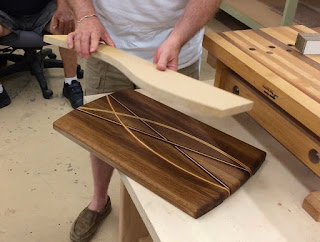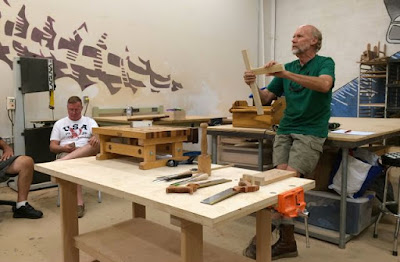As usual, we opened the meeting with our traditional round robin introductions and there were a number of new faces -- Welcome!
Business of the Month
The main item of business seems to be the AWFS fair that will be held at the Las Vegas Convention Center this week; July 22-25. If for some reason you've forgotten about that you can still attend but the fees may be higher than the $25.00 admission. If you've never gone it is truly something to see, as we've discussed a few times though, the classes and presenters aren't up to the same quality as previous years.
Jamie recently ordered a switch for one of her tools which retired electrician Jim, offered to install. The parts came from Delta and they also sent her some pens and t-shirts which Jim happened to be modeling for the meeting!
One of our members, Andrew Tau; talked about his successful Kickstarter project. He shared how he used to be in woodworking but then life got in the way. After the birth of his daughter 2 years ago he decided to build a crib for her which reignited his passion for woodworking. The Kickstarter program is one where you develop a business model, build your product, and then "pitch it" on the Kickstarter website to attract investors. His products are things such as coasters, cutting boards, and other easy to ship pieces. According to Jamie, it's rare for a woodworking project to succeed but he managed to raise over $12,000 and 98 supporters during the two week run of his project. Here is a LINK to his work. Hopefully Andrew will be able to leave his bartender job and pursue this full time.
Show & Tell
 |
| Dennis's Cottonwood Bark Carving |
Show and tell session began with Dennis sharing this really unique carving done out of a piece of Cottonwood tree bark. Dennis and Randy lead the Woodcarvers Group that meets at Woodworkers Emporium on the fourth Saturday of the month. Here is a LINK to their latest newsletter so you can see the sorts of things they do and carve. It's open to carvers of all levels and I can personally vouch for the talent in that group. I've attended a few of the meetings and usually the members bring their chisels and work on projects during the meeting time. This gives you an opportunity to ask questions and get some help so you can improve your own work.
 |
| The Mouse takes the Cheese |
Dennis also brought in this little mouse that "took the cheese"!
 |
| Beth's Steep Stool |
Braxton brought in a Pine box that featured hand cut dovetails. It is his first attempt at dovetailing and they looked really nice. Inside were many beverage cozies that we were welcome to take one of as the box made it's way around the room. Unfortunately, we didn't get a picture of it.
 |
| Pete's Cutting Board |
 |
| Denny's Cherry Table |
Hopefully, you all had a chance to check out Denny's latest project in the other room as it was too large to bring into where we met. It's a Farmhouse style dining table made out of Cherry. As you know, Jamie's woodworking style is one of speed driven quality. She mentioned that Denny has been talking about his need for a table and on a recent trip to purchase lumber for the school she talked him into just doing it. This table was built in about 20 hours under the direction/urging of Jamie. Very nicely done!
Featured Presentation
 |
| Hand Cut Mortise & Tenon: John Eugster |
 |
| Mortise chisel, tape is used to show depth |
The work begins by holding the mortise chisel vertically and about 1/4" away from your line. It's up to you to maintain 90 degrees while chopping. The initial cut is made and then…..
….. the chisel is moved about 1/4" further and another cut is made. You can now lever the chisel so that the chips come out behind. The bevel on your chisel faces the direction of travel. You can either start your cut at one side of the mortise and work your way to the other which is what I'm showing here. You can also start at the center, work to required depth, and then go out to the sides from there.
Here the mortise is almost done except finishing up the left shoulder.
As the completed mortise was passed around the room you no doubt noticed that the bottom of it is pretty ragged. In actuality that's not too critical because the strength comes from the face grain off the cheeks. You can use a specialty chisel called a Swan Neck to make the bottom smooth.
Next up is cutting the tenon on the end of the other piece being joined. This too is done with the mortising gauge and marking knives.
The first cuts are the shoulder cuts and I use a chisel to deepen that line to help guide the saw. Vision and good light are needed whenever you do precision hand tool woodworking. I had a lot of comments about the headlamp I'm using which really helps. It's from REI and you can recharge it with a USB port on your computer so batteries are not an issue. Here is a LINK to it if you're interested.
After cutting the shoulders it's time to cut the cheeks. I'm using a rip-cut dovetail saw.
There are a variety of ways to trim your tenon to fit the mortise. You can use a chisel or a shoulder plane. My tool of choice is either a rabbet block plane or a Stanley #71 Router Plane or newer model.
 |
| John Made tool |
Here's a picture of the completed sample joint. You can see that the shoulders are tight and the two pieces line up almost flush. This is where you'd use a low angle block plane to even them out.
Thanks to Lupe's great video/photography you have this video to better illustrate the process. Thanks for all the questions during my demo, hope it was beneficial to your own work.













